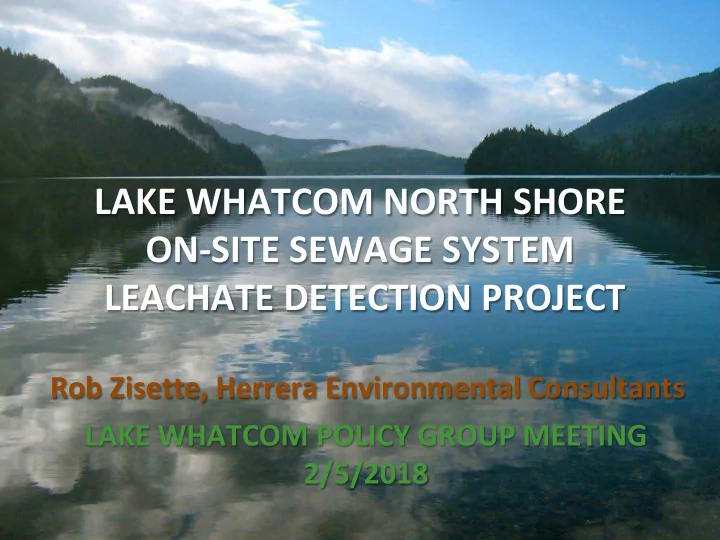

LAKE WHATCOM NORTH SHORE ON-SITE SEWAGE SYSTEM LEACHATE DETECTION PROJECT Rob Zisette, Herrera Environmental Consultants LAKE WHATCOM POLICY GROUP MEETING 2/5/2018
Presentation Outline Project setting/need Site conditions Study design Monitoring results Correlation analysis Study conclusions Next steps 2
Project Setting Lake Whatcom supplies water to ~100,000 people in Bellingham, WA area TMDL implementation plan North Shore Road for phosphorus and fecal coliform bacteria requiring 20-96% reduction in streams Entire watershed is a sensitive area that is mostly sewered with 650 OSS 3 3
Project Need Lake Whatcom Water and Sewer District (LWWSD) is working with other jurisdictions to protect lake water quality, and is concerned about OSS contamination and eutrophication of their water supply. LWWSD is investigating a sewer extension to over 99 homes with OSS on 2.5 miles of North Shore Road. Sewer extension would require a conditional use permit for existing Rural Residential land use with evidence that the sewer is necessary to protect both public health and environmental impacts to Lake Whatcom. 4
North Shore Road Study Area 99 OSS with 50% built before 1990 regulations 5 5
2015 OSS Inspection Records 55 inspected 2013-2015 WCHD OSS compliance 39 inspected 2009-2012 emphasis began in 2016 2 never inspected 20 inspected by homeowner 20 needed maintenance: 8 needed pumping 11 needed minor repairs 1 had failed pump 6 6
High Seepage Contamination Risk Old systems Shallow soils with P saturation Close to lake Shallow water table with High rainfall anoxic Fe-P dissolution Steep slope Underlying bedrock 7
OSS Detection Study Design Target winter wet weather with highest OSS detection 1. potential due to: Soil saturation High shallow ground water table High lake level For increased transport of effluent to drainages and lake via: Shallow groundwater seepage Overland flow of surfacing system failures Cost-effective use of field data to identify hot spots in lake 2. and drainages for sampling and lab analysis Human fecal sources in lake and drainages are from OSS in 3. the subbasin
OSS Detection Methods Optical brighteners Conductivity/multimeter Fecal bacteria Total phosphorus Chloride/bromide Microbial Source Tracking (MST) using two human Bacteroidetes methods by digital quantitative polymerase chain reaction (dPCR) 9
Experimental Design Three boat surveys along shore in winter wet weather 1. Continuously log field measurements and position 2. Use field data to sample hot spots in lake and drainages 3. Sample lake control sites first and OSS site last 4. Event 1 for field tests and 23 fecal bacteria samples 5. Events 2 and 3 for field tests and 18 fecal bacteria 6. sample results to select analysis of 15 samples for: Total phosphorus a. Chloride and bromide b. MST Bacteroidetes qPCR for B. dorei and B. EPA c.
Sample Collection Monitored three events: 1. January 19, 2017 (48-hour rain = 2.20 in, lake level = 312.0 ft) 2. March 15, 2017 (48-hour rain = 0.87 in, lake level = 313.9 ft) 3. March 29, 2017 (48-hour rain = 1.86 in, lake level = 314.6 ft) Continuous field parameters for each event: YSI Multimeter (position, temp, DO, pH, conductivity, turbidity) Turner Cyclops-7 fluorometer (optical brighteners) Samples collected by peristaltic pump from field probe location at: 2-3 lake control stations 1-3 lake impact stations 11-14 discharge stations 1 OSS station
Sampling Station Locations 12
13
14
15
16
17
18
MST Method Accuracy and Precision Method comparison study using 27 labs: B. dorei has high sensitivity, low false negatives B. EPA has high selectivity, low false positives Source Molecular analysis of 3 years of data: 85% of samples had B. dorei detected and B. EPA not detected or at lower concentration dPCR increases sensitivity by amplifying multiple droplets versus one aliquot by qPCR Each sample analyzed in duplicate and re-analyzed if COV exceeds 30%
Results – Medians/Geomeans Parameter Lake Control Lake I mpact Discharge OSS Conductivity (µS/cm) 57.3 60.9 59.0 954 Optical brighteners (RFUB) 43.4 81.2 660 189 Total phosphorus (mg/L) <0.008 0.021 0.054 10.3 Fecal coliform (CFU/100 mL) 3 10 36 2,470,000 E. coli (CFU/100 mL) 3 10 28 2,470,000 B. dorei (copies/100 mL) 1.4 3.7 8.4 1,230 B. EPA (copies/100 mL) 0 0 4.6 88,100
Fecal Coliform Bacteria Results • Rated relative to Recreation Standard (100) • High (> std) in 9/18 discharges in 5 areas, but no lake samples • Maximum (800) less than typical stormwater
Human Bacteroidetes Results • High (> 100 DL) at 2 discharges (1~ OSS but with moderate fecals) • Moderate (> DL) at 4 discharges and 1 lake station
Fecal Coliform vs. Optical Brighteners 1000 Fecal Coliform Bacteria (CFU/100 mL ) 100 10 1 0 50 100 150 200 250 300 350 Optical Brighteners (RFUB) Discharge Lake
Total Phosphorus vs. Optical Brighteners 0.25 0.2 Total Phosphorus (mg/L) 0.15 0.1 0.05 0 0 50 100 150 200 250 300 350 Optical Brighteners (RFUB) Discharge Lake
Conclusions Indications that OSS are impacting the lake with fecal bacteria and phosphorus in the study area Human fecal bacteria were detected at moderate to high DNA concentrations at 6 of 18 discharges to lake in study area, with one discharge containing amounts found in OSS samples Fecal bacteria concentrations are not good indicators of human sources in the lake or discharges Optical brightener fluorescence is a good indicator of fecal bacteria and total phosphorus
Next Steps WCHD is conducting OSS regulation compliance investigation and enforcement Herrera will complete OSS phosphorus loading analysis Lake Whatcom Management Team will lead modified OSS input sampling in winter of 2018/2019 to confirm findings and evaluate OSS investigation effectiveness
Questions? rzisette@herrerainc.com 27
Phosphorus Loading Analysis Method Contaminated and uncontaminated discharges based on human fecal marker detection Flow-weighted average TP concentration for existing and OSS-corrected discharges, by reducing TP in contaminated discharges to typical TP in uncontaminated discharges. Apply percent reduction in TP for all discharges from existing to OSS-corrected to the TMDL TP loading from North Shore subbasin. Add 25 percent OSS loading from direct seepage to lake
Recommend
More recommend